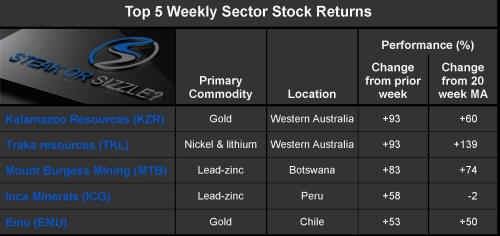The Current View
A lengthy downtrend in sector prices had given way to a relatively stable trajectory after mid 2013 similar to that experienced in the latter part of the 1990s and first few years of the 2000s.
The late 1990s and early 2000s was a period of macroeconomic upheaval during which time sector pricing nonetheless proved relatively stable.
Relative stability suggests a chance for companies genuinely adding value through development success to see their share prices move higher. This was the experience in the late 1990s and early 2000s.
Still vulnerable cyclical conditions were aggravated in the second half of 2015 by a push from investors worldwide to reduce risk. Sector prices were pushed to a new cyclical low. These conditions were largely reversed through the first half of 2016 although sector prices have done little more than revert to mid-2015 levels.
With a median decline in prices of ASX-listed resources companies through the cycle of 89%(and 30% of companies suffering a decline of more then 95%), the majority of stocks remain prone to strong 'bottom of the cycle' leverage in response to even slight improvements in conditions.
Has Anything Changed?
A 1990s scenario remains the closest historical parallel although the strength of the US dollar exchange rate since mid 2014 has added an unusual weight to US dollar prices.
The first signs of cyclical stabilisation in sector equity prices have started to show. This has meant some very strong ‘bottom of the cycle’ gains.
Funding for project development may have passed its most difficult phase at the end of 2015 with signs of deals being done and evidence that capital is available for suitably structured transactions.

Key Outcomes in the Past Week

Market Breadth Statistics



The key US equity price indicators have pushed to new records with a wider array of previously underperforming sectors contributing to the improved outcomes.
Improved US economic performance, including the likelihood of lower US corporate taxes, have helped lift prices. At the same time, the market is discounting the negative impact of stimulus withdrawal by the Federal Reserve.

Equity market volatility has remained at the very bottom of its historical range of outcomes.
Previous views that low volatility would signal an imminent turn in market sentiment have appeared to lose force.

The US exchange rate decline which had prevailed through the first half of 2017 appears to have stalled. The lower US dollar will have contributed positively to the earnings of the largest US corporations and helped boost US dollar denominated commodity prices.

Despite improved US economic performance and the threat of the US Federal Reserve no longer supporting prices, bond yields have remained lower than forecasters would have once thought possible.
The low yields support equity market valuations at higher levels than would otherwise be the case.
Low yields also suggest some scepticism among financial market investors about the prospective strength of the US economy and, in particular, the likely resurgence in inflation that would normally come with growth.
The absence of a stronger rise in long term interest rates makes it more difficult for the finance sector to raise profitability and in turn for an important part of the equity market to sustain higher prices.

Metal prices have generally remained near the upper end of their trading ranges for 2017 although the power of the rise appears to have diminished with nickel prices moving markedly lower.
Tin prices never joined the mid year rally and remain little different than they were at the beginning of the year.

The move up in copper prices in the past week coincided with the upward drift in bond yields suggesting that both moves might have reflected slightly stronger sentiment about global growth prospects.

Iron ore prices moved appreciably lower in the past week as the momentum of Chinese steel price rises declined.

Uranium related equity prices have drifted toward the lower bound of the very narrow trading range they have occupied over the past year and as the sector attempts to form a cycle bottom.

Oil exploration related equities had broken above their downtrend but some weakness in oil prices over the past week held back the prices of this part of the industry most highly leveraged to industry condtions.

The Australian dollar had receive a boost from stronger bulk commodity prices. With prices giving up some of the gains in the last week, the Australian dollar experienced some pullback.
The lower dollar should have helped the value positioning of those commodity producers active outside the bulk commodity segment of the market.

Australian gold equity values made modest gains despite the lower US dollar gold bullion price during the week.
.
The Steak or Sizzle? blog LINK contains additional commentary on the best performed stocks in the sector and the extent to which their investment outcomes are underpinned by a strong enough value proposition to sustain the gains.
